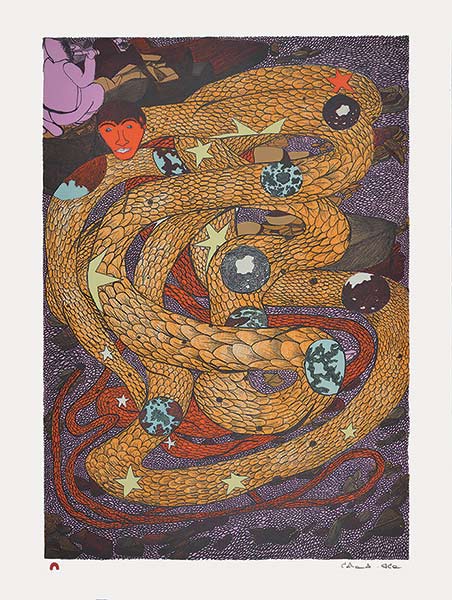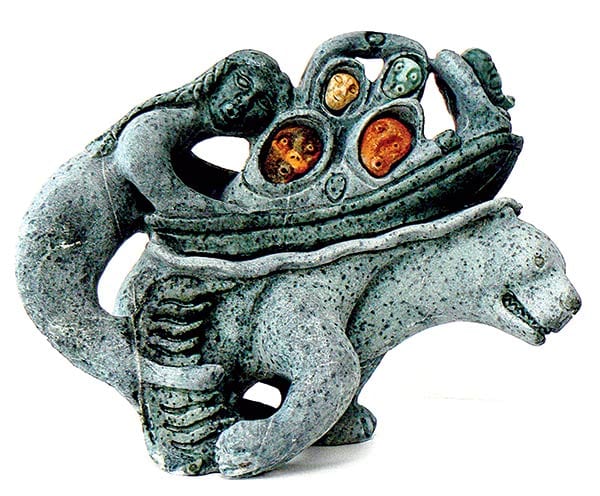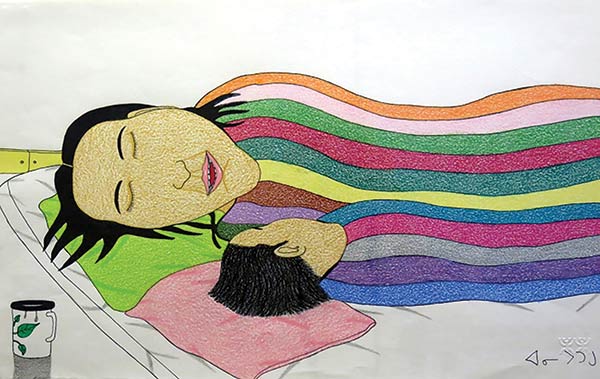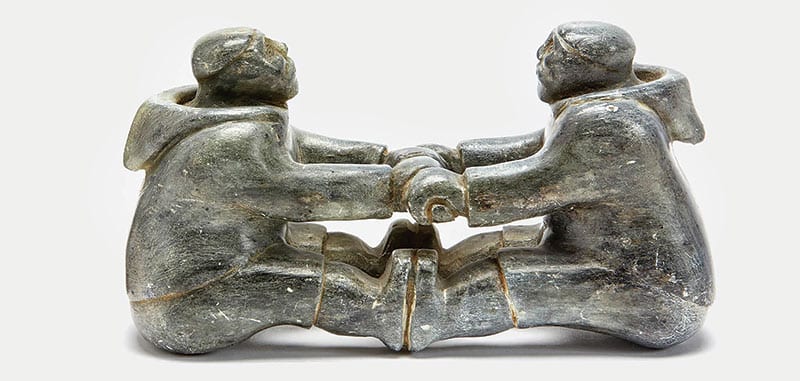Global warming is having a profound effect on the circumpolar world. Late ice formation and early melt are changing animal behaviour and ancestral travel routes long-used by the Inuit people. Inuit artists are increasingly taking on these political, environmental and identity questions in their work. But while a contemporary artist working in Vancouver, Toronto or Montreal would be praised, debated and celebrated as a provocateur for tackling these issues, Inuit artists working with the same themes are often ignored by the contemporary art world and visual arts market. And according to some experts, the public has no idea what it’s missing out on.
Back in the 1900s, the Canadian government had actively encouraged carving and art production among indigenous people in Canada’s Far North. The government hoped it would encourage economic self-sufficiency among the Inuit people, who were being transitioned out of their traditional semi-nomadic hunting and gathering lifestyle and settled into permanent communities.
In the 1950s, Canadian artist James Houston moved to Cape Dorset, an island community off the south-west coast of Baffin Island, where he taught locals how to draw and make prints. Starting in 1959, the prints produced in Cape Dorset were released in an annual collection.

Although carvings produced throughout the North remained hugely popular, the Cape Dorset prints of Arctic nature and traditional Inuit life became a hit in the art world and a favourite among collectors.
The collection’s success inspired other northern communities, like Ulukhaktok (Holman), Northwest Territories; Baker Lake, Nunavut; and Puvirnituq, Quebec, to set up similar arts studios or centres.
Inuit art was now officially on the map. But there’s arguably a downside to all this. The marketing of traditional Inuit carvings and imagery to the South has been so successful that ‘Inuit art’, in the minds of most people, has become synonymous with depictions of a romanticised past in Canada’s pristine North.
Fifty years after her work first appeared in the Cape Dorset print collection, artist Kenojuak Ashevak remains a Canadian superstar for her imagery of Arctic nature and wildlife. Her work has been replicated on everything from Canadian stamps to stained glass windows.
As issues like Arctic sovereignty and global temperature change increasingly push Northern issues onto news broadcasts and into headlines, some think Canada’s southern arts community is slowly waking up to contemporary work from the Arctic
But for Northern artists exploring contemporary themes, that kind of success is almost unimaginable.
Even after the success of Inuit artist Annie Pootoogook, whose images of contemporary family life in the North helped her snatch the 2006 Sobey Art Award, one of Canada’s most prestigious art prizes, the contemporary market in southern Canada has been slow to accept new imagery emerging out of the North.

That’s left many Inuit artists stranded between a southern art market that clamours for depictions of an idealised Inuit lifestyle that no longer exists and a contemporary art world from which they’re often excluded. But likely none of the reasons for that exclusion are fair. As a result, Inuit art is generally marketed, exhibited and distributed apart from the contemporary Canadian art scene – a sphere that’s often focused on a few select themes, centres, styles and courses of training.
Robert Kardosh, a curator of the Marion Scott Gallery in Vancouver, British Columbia, regularly organises exhibitions by Inuit artists who explore contemporary themes, but he admits it’s a challenge just to get contemporary art journals and critics out to the exhibitions.
“I’m not sure if it’s prejudice,” Kardosh says. “But as long as Inuit art is treated as ‘not real art’, or as simply ethnological art, people are missing out.

“The classic Inuit art of the past is spectacular and should absolutely be treasured. But art changes. It’s silly to think that for some reason, Inuit art shouldn’t.”
Independent art curator Nancy Campbell is one of a handful of Canadians working to change the perception of Inuit art. “I walk a very fine line in what I do it,” she says, continuing, “my curating work often isn’t ‘contemporary’ enough for the contemporary market and it’s not ‘Inuit’ enough for collectors of traditional Inuit art.
“I think that both collectors of traditional Inuit art and contemporary art critics have preconceived notions about the Arctic. Most of them have never been there, so they haven’t seen first hand both how beautiful and how tragic it is. It’s both aspects that make the North so fascinating, but I think a lot of people still don’t want to see both sides.”
Acknowledging the vitality, relevance and importance of modern Inuit art is also a tacit acknowledgement that both Inuit and non- Inuit peoples live in a shared world, experiencing a shared present and occupying a shared globe
However, as issues like Arctic sovereignty and global temperature change increasingly push Northern issues onto news broadcasts and into headlines, some think the southern arts community is slowly waking up to contemporary work from the Arctic.

The high cost of travel to the North means that few Canadians will ever see day-to-day life in the Arctic first hand. According to some experts, contemporary visual arts may be among the most important cultural records of how rapid environmental and social change is altering the North.
“It is vital that we, as audiences, embrace and encourage new Inuit art that explores contemporary issues,” says Norman Vorano, curator of Contemporary Inuit Art at the Canadian Museum of Civilisation in Gatineau, Quebec. “Most importantly because the Inuit people have important perspectives on issues that concern us all, like environmental change, society, treatment of elders and even things like business. The list could go on and on…”

“Appreciating modern Inuit art helps us move beyond the old colonial lens when the Inuit were seen as belonging to a distant past, living outside the present,” he says. “Acknowledging the vitality, relevance and importance of modern Inuit art is also a tacit acknowledgement that both Inuit and non-Inuit peoples live in a shared world, experiencing a shared present and occupying a shared globe.”

But until that day, Inuit artists like Jutai Toonoo say they’ll just continue doing what they’re doing.
“I don’t really care about the art world,” Toonoo says. He’s more concerned with working on his drawing than considering where his work may one day fall in the Canadian art canon.
“This is just something I do,” he says, adding colour to the paper with small careful strokes.
“Lots of times it’s just something I’ve observed in the community or the world, and I just put it on whatever I’m working on.
“Put it out there just so that it’s showing.
“And not hidden.”
Source: rcinet.ca